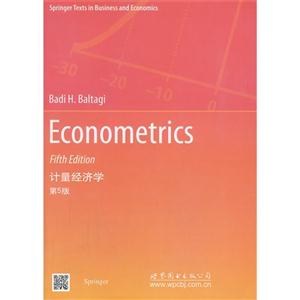计量经济学-第5版
内容简介
[
this book is intended for a first year graduate course in
econometrics. i tried to strike a balance between a rigorous
approach that proves theorems, and a completely empirical approach
where no theorems are proved. some of the strengths of this book
lie in presenting some difficult material in a simple, yet rigorous
manner. for example, chapter 12 on pooling time-series of
cross-section data is drawn from my area of expertise in
econometrics and the intent here is to make this material more
accessible to the general readership of econometrics.
]
目录
prefacepart i1 what is econometrics?1.1 introduction1.2 a brief history1.3 critiques of econometrics1.4 looking aheadnotesreferences2 basic statistical concepts2.1 introduction2.2 methods of estimation2.3 properties of estimators2.4 hypothesis testing2.5 confidence intervals2.6 descriptive statisticsnotesproblemsreferencesappendix3 simple linear regression3.1 introduction3.2 least squares estimation and the classical assumptions3.3 statistical properties of least squares3.4 estimation of er23.5 maximum likelihood estimation3.6 a measure of fit3.7 prediction3.8 residual analysis3.9 numerical example3.10 empirical exampleproblemsreferencesappendix4 multiple regression analysis4.1 introduction4.2 least squares estimation4.3 residual interpretation of multiple regression estimates4.4 overspecification and underspecification of the regressionequation4.5 r-squared versus r-bar-squared4.6 testing linear restrictions4.7 dummy variablesnoteproblemsreferencesappendix5 violations of the classical assumptions5.1 introduction5.2 the zero mean assumption5.3 stochastic explanatory variables5.4 normality of the disturbances5.5 heteroskedasticity5.6 autocorrelationnotesproblemsreferences6 distributed lags and dynamic models6.1 introduction6.2 infinite distributed lag6.2.1 adaptive expectations model (aem)6.2.2 partial adjustment model (pam)6.3 estimation and testing of dynamic models with serialcorrelation6.3.1 a lagged dependent variable model with ar(l)disturbances6.3.2 a lagged dependent variable model with ma(l)disturbances6.4 autoregressive distributed lagnoteproblemsreferencespart ⅱ7 the general linear model: the basics7.1 introduction7.2 least squares estimation7.3 partitioned regression and the frisch-waugh-lovelltheorem7.4 maximum likelihood estimation7.5 prediction7.6 confidence intervals and test of hypotheses7.7 joint confidence intervals and test of hypotheses7.8 restricted mle and restricted least squares7.9 likelihood ratio, wald and lagrange multiplier testsnotesproblemsreferencesappendix8 regression diagnostics and specification tests8.1 influential observations8.2 recursive residuals8.3 specification tests8.4 nonlinear least squares and the gauss-newton regression8.5 testing linear versus log-linear functional formnotesproblemsreferences9 generalized least squares9.1 introduction9.2 generalized least squares9.3 special forms of ω9.4 maximum likelihood estimation9.5 test of hypotheses9.6 prediction9.7 unknown ω9.8 the w, lr and lm statistics revisited9.9 spatial error correlationnoteproblemsreferences10 seemingly unrelated regressions10.1 introduction10.2 feasible gls estimation10.3 testing diagonality of the variance-covariance matrix10.4 seemingly unrelated regressions with unequalobservations10.5 empirical examplesproblemsreferences11 simultaneous equations model11.1 introduction11.1.1 simultaneous bias11.1.2 the identification problem11.2 single equation estimation: two-stage least squares11.2.1 spatial lag dependence11.3 system estimation: three-stage least squares11.4 test for over-identification restrictions11.5 hausman’s specification test11.6 empiri,cal examplesnotesproblemsreferencesappendix12 pooling time-series of cross-section data12.1 introduction12.2 the error components model12.2.1 the fixed effects model12.2.2 the random effects model12.2.3 maximum likelihood estimation12.3 prediction12.4 empirical example12.5 testing in a pooled model12.6 dynamic panel data models12.6.1 empirical illustration12.7 program evaluation and difference-in-differencesestimator12.7.1 the difference-in-differences estimatorproblemsreferences13 limited dependent variables13.1 introduction13.2 the linear probability model13.3 functional form: logit and probit13.4 grouped data13.5 individual data: probit and logit13.6 the binary response model regression13.7 asymptotic variances for predictions and marginaleffects13.8 goodness of fit measures13.9 empirical examples13.10 multinomial choice models13.10.1 ordered response models13.10.2 unordered response models13.11 the censored regression model13.12 the truncated regression model13.13 sample selectivitynotesproblemsreferencesappendix14 time-series analysis14.1 introduction14.2 stationarity14.3 the box and jenkins method14.4 vector autoregression14.5 unit roots14.6 trend stationary versus difference stationary14.7 cointegration14.8 autoregressive conditional heteroskedasticitynoteproblemsreferencesappendixlist of figureslist of tablesindex
封面

书名:计量经济学-第5版
作者:(美)博尔特基 著
页数:410
定价:¥99.0
出版社:世界图书出版公司
出版日期:2013-10-01
ISBN:9787510061424
PDF电子书大小:84MB 高清扫描完整版
